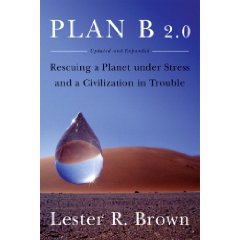 Best Single Book for Both General Public and Broadly Read Specialists,
Best Single Book for Both General Public and Broadly Read Specialists,
Each of the following section titles has six sub-titles that I will not repeat here:
1. Entering a New World
2. Beyond the Oil Peak
3. Emerging Water Shortages
4. Rising Temperatures & Rising Seas
5. Natural Systems Under Stress
6. Early Signs of Decline
7. Eradicating Poverty, Stabilizing Populations
8. Restoring the Earth
9. Feeding Seven Billion Well
10. Stabilizing Climate
11. Designing Sustainable Cities
12. Building a New Economy
13. Plan B: Building a New Future.
Although an updated version of the first edition published in 2003, this version can be said to be both completely new, and finally ready for public consumption now that Al Gore has put Global Warming on the public mind.
I still prefer J. F. Rischard's High Noon 20 Global Problems, 20 Years to Solve Them for the general reader, and I still think E. O. Wilson's The Future of Life is one of the top three in this area, but this book by Lester Brown has the merit of consolidating and structuring detail in a manner I have not seen elsewhere.
I recommend the book be ready in conjunction with books by Herman Daly's Valuing the Earth: Economics, Ecology, Ethics and Paul Hawken's Natural Capitalism: Creating the Next Industrial Revolution, in part because everyone is now starting to realize that green sustainability is in fact the non-negotiable first step for any business to survive into the next decade–natural capitalism.
Most intriguing to me, and the heart of the book on page 257, is the consolidated Plan B budget totallying $161 billion a year needed to meet all of the goals the author postulates.
BASIC SOCIAL GOALS
12B Universal primary education
04B Adult literacy
06B School lunch in 44 poorest countries
04B Assistant to pregnant women and preschool childen in 44 poorest
07B Reproductive health and family planning
33B Universal health care
02B Closing the condom gap (Bill & Melinda Gates can have this one)
EARTH RESTORATION GOALS
06B Reforesting the earth
24B Protecting topsoil on cropland
09B Restoring rangelands
10B Stabilizing water tables
13B Restoring fisheries
31B Protecting biological diversity
As the author points out on the next page, world military expenditures total $975B a year, with the US alone responsible for $492B (this was published before we all knew of the half trillion dollar cost of the Iraq invasion and occupation). Hence, the $161B a year total is a fraction of the total spent on out-dated military systems, and could be funded by the US alone if we had the right leadership and public consensus.
Personally, and based on other readings, I believe that the author is under-estimating the costs, and avoiding a focus on many other factors including the urgent need to eradicate transnational crime and end inter-state and civil war. This is, however, a superb start and ideally suited as a primer for any level of learning.
Readers interested in seeing a broader perspective that places the ten high-level threats (poverty, infectuous disease, environmental degradation, inter-state conflict, civil war, genocide, other atrocities, proliferation, terrorism and transnational crime) in the context of the twelve policies that must be managed as a whole by all nations (agriculture, debt, diplomacy, economy, education, energy, family, immigration, justice, security, society, and water), and that in turn oriented toward the urgency of keeping the eight challengers (Brazil, China, Indonesia, India, Iran, Russia, Venezuela, Wild Cards) from repeating our mistakes, can check in at Earth Intelligence Network.
Rescuing are planet and our civilization is going to be a great deal harder than the author suggests, and is going to need a massive awakening by the public as to the “true cost” of all that we are doing wrong. I expect that we will succeed, in part from top down efforts by Al Gore and this author among others, and in part by bottom up efforts where individuals can get from the Internet the “true cost” of any good or service in terms of water content, fuel content, sweatshop labor content, and tax avoidance status. Noami Klein's books, No Logo: No Space, No Choice, No Jobs and The Shock Doctrine: The Rise of Disaster Capitalism are recommended in this regard.
Over-all an absolutely superb piece of work that caps the author's decades of advocacy on behalf of the planet. There is no other person that has been focused on this topic with due diligence year after year.
I believe this author should be recognized, along with Herman Daly and Paul Hawken and Anthony Lovins and others, for their total commitment over decades.

Click Here to Vote on Review at Amazon,
on Cover Above to Buy or Read Other Reviews,
I Respond to Comments Here or There



